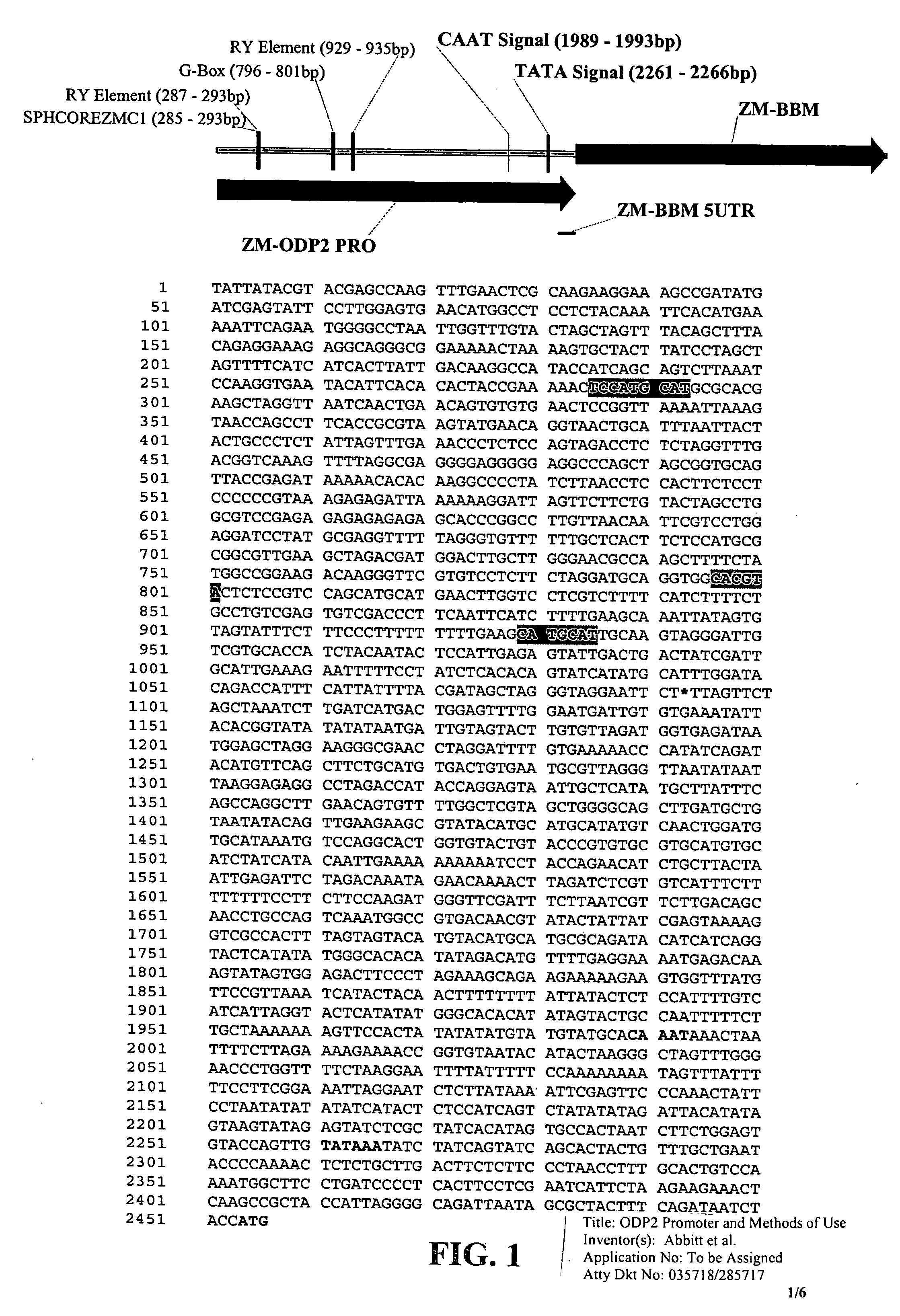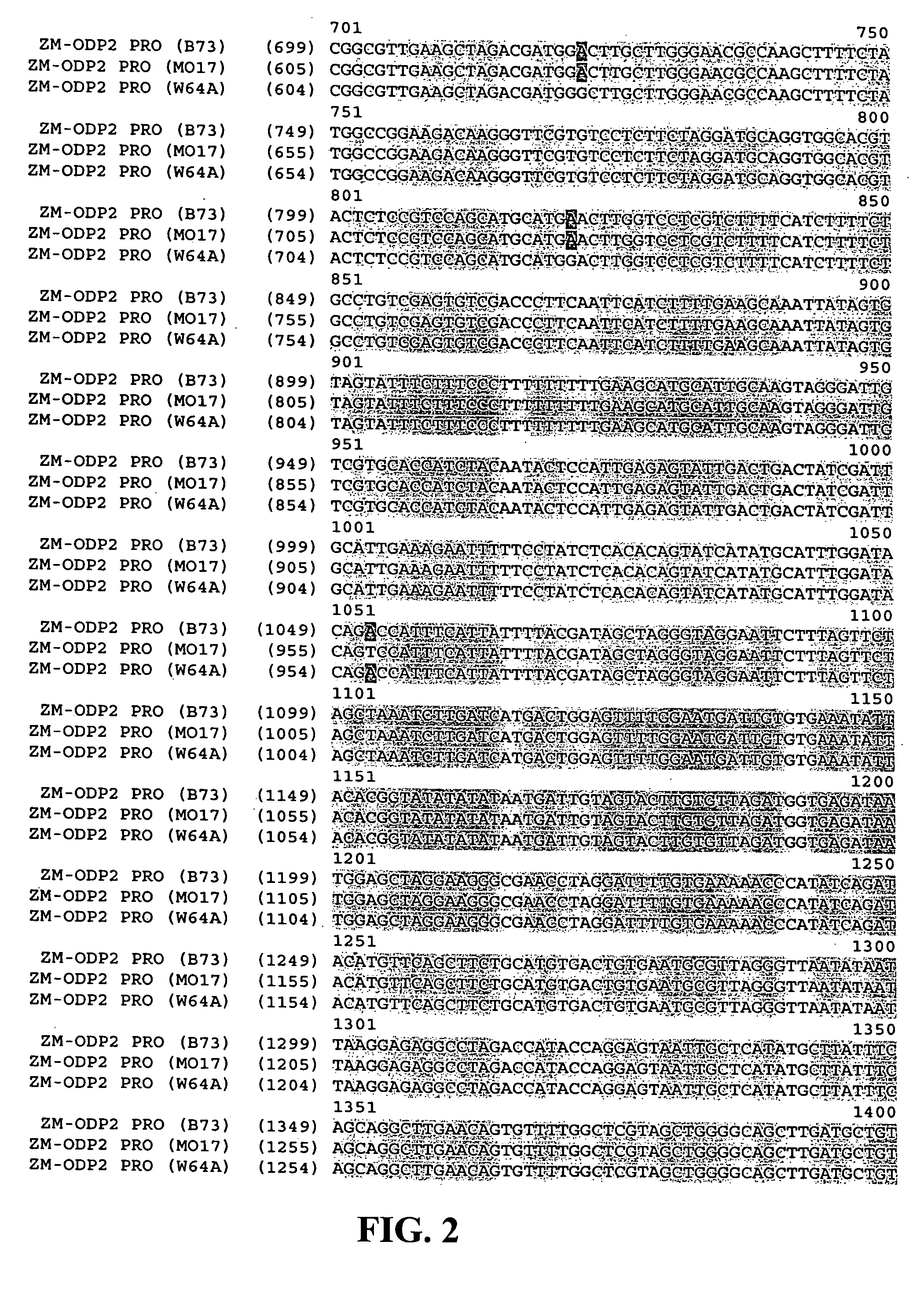ODP2 promoter and methods of use
a promoter and promoter technology, applied in the field of plant molecular biology, can solve problems such as unsatisfactory phenotypic and argonomic effects
- Summary
- Abstract
- Description
- Claims
- Application Information
AI Technical Summary
Benefits of technology
Problems solved by technology
Method used
Image
Examples
example 1
Isolation of the ODP2 Promoter
[0106] Sequences overlapping the 5′ end of the ODP2 transcript were obtained by BLASTing against the Genome Survey Sequence (GSS) Dataset in the NCBI database. This provided us with 2453 bp of sequence upstream of the start codon. Based on that sequence, three sets of PCR primers were created to verify that the sequence was overlapping with the ODP2 transcript in maize (B73) genomic DNA using the High Fidelity Polymerase Supermix from Invitrogen. The amplifications products were isolated and cloned into pGEMT-easy (Invitrogen) and sequenced.
Verification Primers
[0107] Product of length 1011 bp
TGTACATGCATGCGCAGATA(SEQ ID NO:4)CAAACTGTGCTGCTAGTGCT(SEQ ID NO:5)
[0108] Product of length 1810 bp
TTTGAAGCATGCATTGCAAG(SEQ ID NO:6)CAAACTGTGCTGCTAGTGCT(SEQ ID NO:5)
[0109] Product of length 2635 bp
TGAAAAATTCAGAATGGGGC(SEQ ID NO:7)CAAACTGTGCTGCTAGTGCT(SEQ ID NO:5)
[0110] The PCR results were positive, indicating that the sequence was upstream of the transcrip...
example 2
Transformation of Maize and Regeneration of Transgenic Plants
[0113] Immature maize embryos from greenhouse donor plants are bombarded with a plasmid containing the ODP2 promoter (SEQ ID NO:1) operably linked to a nucleotide sequence of interest and the selectable marker gene PAT (Wohlleben et al. (1988) Gene 70:25-37), which confers resistance to the herbicide Bialaphos. Alternatively, the selectable marker gene is provided on a separate plasmid. Transformation is performed as follows. Media recipes follow below.
Preparation of Target Tissue
[0114] The ears are husked and surface sterilized in 30% Clorox bleach plus 0.5% Micro detergent for 20 minutes, and rinsed two times with sterile water. The immature embryos are excised and placed embryo axis side down (scutellum side up), 25 embryos per plate, on 560Y medium for 4 hours and then aligned within the 2.5-cm target zone in preparation for bombardment.
Preparation of DNA
[0115] A plasmid vector comprising the ODP2 promoter (SEQ ...
example 3
Agrobacterium-Mediated Transformation of Maize and Regeneration of Transgenic Plants
[0125] For Agrobacterium-mediated transformation of maize with a polynucleotide construct comprising the ODP2 promoter (SEQ ID NO:1) operably linked to a nucleotide sequence of interest, preferably the method of Zhao is employed (U.S. Pat. No. 5,981,840, and PCT patent publication WO98 / 32326; the contents of which are hereby incorporated by reference). Briefly, immature embryos are isolated from maize and the embryos contacted with a suspension of Agrobacterium, where the bacteria are capable of transferring the polynucleotide construct to at least one cell of at least one of the immature embryos (step 1: the infection step). In this step the immature embryos are preferably immersed in an Agrobacterium suspension for the initiation of inoculation. The embryos are co-cultured for a time with the Agrobacterium (step 2: the co-cultivation step). Preferably the immature embryos are cultured on solid med...
PUM
| Property | Measurement | Unit |
|---|---|---|
| temperature | aaaaa | aaaaa |
| temperature | aaaaa | aaaaa |
| pH | aaaaa | aaaaa |
Abstract
Description
Claims
Application Information
 Login to View More
Login to View More - R&D
- Intellectual Property
- Life Sciences
- Materials
- Tech Scout
- Unparalleled Data Quality
- Higher Quality Content
- 60% Fewer Hallucinations
Browse by: Latest US Patents, China's latest patents, Technical Efficacy Thesaurus, Application Domain, Technology Topic, Popular Technical Reports.
© 2025 PatSnap. All rights reserved.Legal|Privacy policy|Modern Slavery Act Transparency Statement|Sitemap|About US| Contact US: help@patsnap.com



